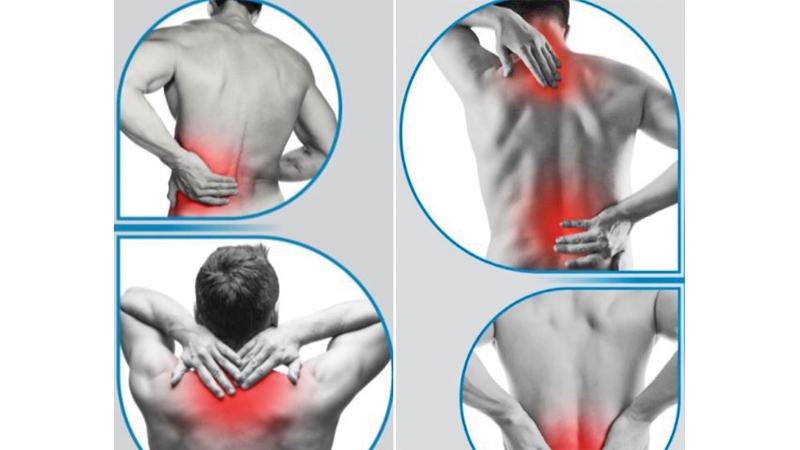
Myofascial pain syndrome is a chronic pain disorder. In this condition, pressure on sensitive points in the muscles (trigger points) causes pain in the muscles and sometimes in unrelated parts of your body. This is called referred pain.
 This syndrome typically occurs after a muscle has been contracted repetitively. This can be caused by repetitive motions used in jobs or hobbies or by stress-related muscle tension.
This syndrome typically occurs after a muscle has been contracted repetitively. This can be caused by repetitive motions used in jobs or hobbies or by stress-related muscle tension.
While nearly everyone has experienced muscle tension pain at some stage of their Iives the discomfort associated with myofascial pain syndrome persists or worsens over time.
Symptoms
Signs and symptoms of myofascial pain syndrome may include:
Deep aching pain in a muscle or muscles
Pain that persists or worsens over time
A tender spot or spots in a muscle
Difficulty sleeping due to pain (Insomnia)
Causes
Sensitive areas of tight muscle fibres can form in the muscles after injuries or overuse. These sensitive areas are called trigger points. A trigger point in a muscle can cause strain and pain throughout the muscle. When this pain persists and worsens, doctors call it myofascial pain syndrome.
Risk factors
Myofascial pain syndrome is caused by a stimulus, such as muscle tightness, that sets off trigger points in your muscles. Factors that may increase the risk of muscle trigger points include:
Muscle injury. An acute muscle injury or continuous muscle stress may lead to the development of trigger points. For example, a spot within or near a strained muscle may become a trigger point. Repetitive motions and poor posture also may increase your risk.
Stress and anxiety. People who frequently experience stress and anxiety may be more likely to develop trigger points in their muscles. One theory holds that these people may be more likely to clench their muscles, a form of repeated strain that leaves muscles susceptible to trigger points. Sometimes pain anxiety and depression will be the presenting symptoms (PAD syndrome).
Treatment
Pain medications according to the WHO analgesic ladder described in previous articles
Physiotherapy
Acupuncture
Heat therapy
Hydrotherapy
Trigger point injections can be carried out in a procedure room, doctor’s room, to minimise cost.
Depomedrone or Triamcenalone mixed with Lidocaine is injected to the trigger points. This is quite effective. Pain relief can last three to six months or even longer.
By carrying out trigger point (TPI) injections the vicious cycle is interrupted and a window of pain free period is given. This will help patients to get back to normal activity. This is very important for patients to get on with normal life.
Complications
Complications associated with myofascial pain syndrome may include:
Sleep problems. Signs and symptoms of myofascial pain syndrome may make it difficult to sleep at night. You may have trouble finding a comfortable sleep position. And if you move at night, you might hit a trigger point and awaken. Lack of sleep will worsen the pain and vice versa.
Fibromyalgia. Some research suggests that myofascial pain syndrome may develop into fibromyalgia in some people. Fibromyalgia is a chronic condition that features widespread pain. It’s believed that the brains of people with fibromyalgia become more sensitive to pain signals over time. Some doctors believe myofascial pain syndrome may play a role in starting this process.
When to see a doctor
Make an appointment with your doctor ideally a pain consultant if you experience muscle pain that doesn’t go away. Nearly everyone experiences muscle pain from time to time. But if your muscle pain persists despite rest, massage and similar self-care measures, and make an appointment with your doctor.
Case Review - Recently a female patient in her early forties saw me in clinic (in Colombo)together with her husband. She came with 4 sets of MRI scans (paid for on 4 occasions). Her main complaint was pain in the lower back. Her symptoms did not warrant an MRI scan at all. As I expected the scans were normal. She had multiple trigger points with myofascial pain. I realised that she was depressed and asked her the question. She started to cry. She had difficulty at her workplace. As most patients she explained that her depression is due to the pain she suffers. But I thought otherwise. It is like the chicken and the egg scenario. I put her on anti depressants for four weeks together with a sleeping pill as her sleep was affected. I am hoping to carry out trigger point injections once her depression is controlled. Depression can be under diagnosed in Sri Lanka as it can present with agitation than low mood.
Dr Namal Senasinghe MBBS, Dip in Pain Med, FFARCS, FFPMCA, CCST(U.K) Consultant in pain medicine @ the ‘London Pain Management Centre,’ No. 31, Horton Place, Colombo 7, Sri Lanka. Hotline 0767155716.
